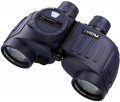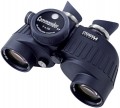Field of view 1 km away
The diameter of the area visible through binoculars / monoculars from a distance of 1 km — in other words, the largest distance between two points at which they can be seen simultaneously from this distance. It is also called "linear field of view". Along with the angular field of view (see below), this parameter characterizes the space covered by the optics; at the same time, it describes the capabilities of a particular model more clearly than data on viewing angles. Models with magnification adjustment (see above) usually indicate the maximum field of view — at the lowest magnification and
the widest angle of view. This information is often supplemented by data on the minimum value.
Diopter adjustment
The presence in binoculars / monoculars of the function of diopter correction. This feature will be very useful if you wear glasses due to nearsightedness or farsightedness. By setting the required number of "plus" or "minus" diopters on the adjustment scale, you can look into the eyepiece with the naked eye and see a clear picture — the optics of the device will provide the necessary correction. It is much more convenient than watching through glasses. However one should not forget that the correction range (see below) is usually small, and in case of serious visual impairments, the capabilities of the binoculars may not be enough; but such situations are still quite rare. In binoculars (see "Type"), this adjustment is usually carried out for each eyepiece separately, because The diopters required for each eye may also be different. Features of the correction control depend on the type of focus (see below). With separate focus, each eyepiece is adjusted with its own regulator, with the central one of the halves (usually the left) is regulated using a common focus handwheel, and the second with a separate knob on the eyepiece (although here there are separate regulators on both eyepieces).
Ergonomic eyecups
The presence of
beveled eyecups(or one eyecup, in the case of monoculars — see "Type") in the design of the device. The elongated part of the eyecup during operation is located on the outside of the eye, almost on the temple; due to this, it provides additional protection for the eye — primarily from extraneous "flare" that interferes with normal viewing of the image in the eyepiece. At the same time, such models do not go well with glasses: at best, the eyecup will have to be turned up, negating all its advantages, and in some devices this is not even possible.
Compass
The presence of a
compass in the design of binoculars (see "Type"; in monoculars, this function is practically not found for a number of technical reasons). A compass can be useful for navigating the terrain, especially when you are away from civilization — for example, during a hiking or hunting trip. In most cases, it is made in the form of a separate scale with an arrow installed in the upper part of the case; usually such models are professional, and the built-in compasses are not inferior in accuracy to ordinary tourist ones. And in the most advanced devices, the compass scale is superimposed directly on the image visible in the eyepieces — this is very convenient when determining azimuths for individual objects.

